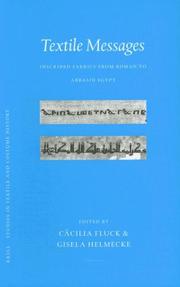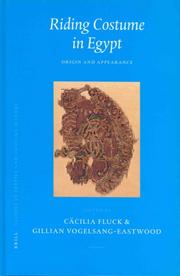| Listing 1 - 3 of 3 |
Sort by
|

ISBN: 9004149562 9789004149564 1134572921 1280290250 9786610290253 0203015630 9780203015636 0415232228 9780415232227 9780415364577 0415364574 6610290253 9781134572878 9781134572915 9781134572922 9789047418290 1134572913 Year: 2006 Volume: 4 Publisher: Leiden Brill
Abstract | Keywords | Export | Availability | Bookmark
 Loading...
Loading...Choose an application
- Reference Manager
- EndNote
- RefWorks (Direct export to RefWorks)
Easy to read, and highly topical, Messages writes a history of mass communication in Europe and its outreaches, as a search for the origins of media forms from print and stage, to photography, film and broadcasting.Arguing that the development of the mass media has been an essential engine driving the western concept of an individual, Brian Winston examines how the right of free expression is under attack, and how the roots of media expression need to be recalled to make a case for the media's importance for the protection of individual liberty.Relating
Textile fabrics, Ancient --- Textiles et tissus antiques --- Textile fabrics [Ancient ] --- Egypt --- Congresses --- Textile fabrics --- Inscriptions --- Mass media --- History. --- Cloth --- Fabrics --- Textile industry and fabrics --- Textiles --- Ancient textile fabrics --- History --- Decorative arts --- Dry-goods --- Weaving --- Textile fibers --- Médias --- Histoire --- Égypte --- Manufacturing technologies --- inscriptions --- textile materials

ISBN: 1280467622 9786610467624 1423714318 9047402383 9781423714316 9789047402381 9789004131637 9004131639 9004131639 Year: 2004 Publisher: Leiden Brill
Abstract | Keywords | Export | Availability | Bookmark
 Loading...
Loading...Choose an application
- Reference Manager
- EndNote
- RefWorks (Direct export to RefWorks)
An extremely rare and conspicuous find of oriental riding costumes in the late antique necropolis of Antinoopolis (Middle Egypt) brought together a number of specialists piecing together their evolution and historical context. The first part deals with the evolution and distribution of the oriental riding costume in the Middle and Near East through the ages and the historical background on the find spot. The second part focuses on the original costumes in various museum collections including much so far unpublished material, technical researches and reconstructions. Surprising new insights on the social background of their owners has been obtained by carefully studying and piecing together the finding context. Also the representations of riding costumes in and on different monuments are carefully examined. The book is richly illustrated with colour and black and white plates.
Horsemen and horsewomen --- Riding habit --- Horsemanship --- Eastern horsemanship --- Eastern riding --- English horsemanship --- English riding --- Equestrianism --- Equitation --- Horse riding --- Horseback riding --- Riding --- Riding, Eastern --- Riding, English --- Locomotion --- Equestrian centers --- Habit, Riding --- Clothing and dress --- Equestrians --- Women equestrians --- Horsemen --- Horsewomen --- Animal specialists --- Costume --- Equipment and supplies. --- Equipment and supplies --- Clothing --- Ethnology. Cultural anthropology --- equestrians --- suits [main garments] --- riding habits --- textile materials --- Egypt
Book

ISBN: 9788897523352 8897523358 8899200106 8897523366 Year: 2015 Publisher: Torino : Accademia University Press,
Abstract | Keywords | Export | Availability | Bookmark
 Loading...
Loading...Choose an application
- Reference Manager
- EndNote
- RefWorks (Direct export to RefWorks)
Il volume raccoglie i saggi presentati in occasione del convegno dal titolo Itinerari mediterranei fra IV e IX secolo: Città-capitale e Deserto-monastico (Genova, 11-12-13 novembre 2010), mettendo in dialogo i contributi di spessore scientifico elaborati da studiosi appartenenti a diverse aree e abbracciando l’articolato contesto del Mediterraneo nella Tarda Antichità e nell’Altomedioevo. Nel risalire alle origini dell’iconografia cristiana, è stato sottolineato il ruolo fondamentale svolto dall’Egitto fra IV e VI secolo dove, grazie all’interazione tra i monasteri cenobitici e i grandi centri urbani del mondo antico, venne elaborato quel sapere figurativo e dottrinale che ha portato alla formazione della “civiltà dell’immagine”, poi sviluppata nel corso dei secoli in Europa. Ed è il denso e ricco rapporto tra questi due poli, Città e Deserto, che costituisce un tassello decisivo nel disegnare le rotte e le dinamiche culturali irradiate nel crogiolo mediterraneo. Il confronto tra le situazioni scelte e analizzate dai relatori traccia percorsi e itinerari a doppio senso. All’interno di questo approccio multi-disciplinare, le tangenze religiose, storiche, geo-politiche, sociali e artistiche stimolano approfondimenti per ulteriori indagini e future collaborazioni nel quadro degli scavi archeologici. In quest’ottica sono presi in considerazione anche i diversi media e tecniche dell’arte – il codice, il tessuto, l’oreficeria, gli avori, l’architettura, la scultura, l’affresco –, ampliando il giro d’orizzonte in cui comprendere i modi di sopravvivenza e di ricezione dell’eredità figurativa che il Mediterraneo ha consegnato.
Church history --- Desert Fathers --- Mediterranean Region --- Fathers of the church --- Circum-Mediterranean countries --- Mediterranean Area --- Mediterranean countries --- Mediterranean Sea Region --- civiltà dell'immagine --- deserto --- storia --- itinerari mediterranei --- convegno --- Medioevo --- antichità --- città --- mediterraneo
| Listing 1 - 3 of 3 |
Sort by
|

 Search
Search Feedback
Feedback About UniCat
About UniCat  Help
Help News
News